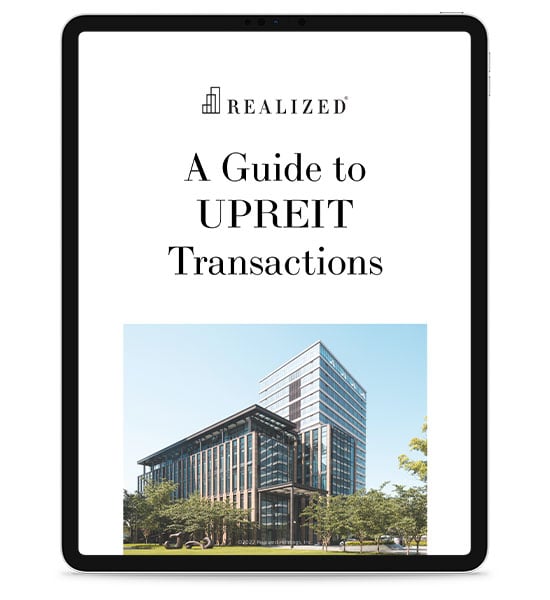
Investors have plenty of options when it comes to the niche of the umbrella partnership real estate investment (UPREIT) they’re going to enter. Two closely related areas that are gaining popularity are the industrial and warehousing sectors, especially with the rise of e-commerce, dropshipping, and last-mile distribution centers.
Before entering an industrial or warehouse UPREIT, you’ll still want to get the full picture, including the risks and opportunities. That way, you can maximize the benefits and plan ahead for the risks. Below, Realized 1031 shares what you need to know.
Recap of UPREITS
UPREITs are investment vehicles that own underlying income-generating properties. Through a 721 exchange, investors can contribute their assets to the UPREIT in exchange for operating partnership (OP) units, which are the economic equivalent of shares. The IRS doesn’t recognize gains or losses for this type of transaction, allowing investors to defer capital gains taxes until a triggering event occurs.
Due to the structure of the UPREIT, in which the REIT has a controlling interest, management of the underlying assets won’t fall to investors. The hands-off involvement and passive income from rent payments make UPREITS appealing to certain types of investors.
The Appeal of Industrial and Warehouse UPREITs
What makes UPREITs that focus on industrial and warehousing facilities attractive today? Here are a few reasons for the heightened appeal.
- E-commerce Growth: The e-commerce industry is expected to have a market value of 4.3 trillion US dollars in 2025, and the figure is going to continue growing. Industrial facilities and warehouses are integral parts of this rise, increasing the chances of stable cash flow.
- Stable Tenancy: Long-term leases with creditworthy tenants like logistics companies and retailers provide reliable income for OP unit holders.
- High Occupancy Rates: Many industrial structures and warehouses in various metro areas are experiencing record-high occupancy rates.
Warehouse and Industrial UPREIT Opportunities
Apart from the inherent nature of warehouses and industrial facilities that make them promising investments, the fact that they’re held by UPREITs adds a few additional benefits.
First, the structure of the UPREIT itself removes the management burden for investors. This benefit is ideal for those nearing retirement or those who no longer want to play an active role in their investments. You earn passive income with minimal effort, in short.
There’s also the matter of liquidity. Compared to direct property ownership, OP units offer more flexibility. They can be easily converted to shares after a brief holding period, making UPREITs ideal for those who see near-future liquidity needs. Keep in mind that this conversion and subsequent sale are a taxable event.
UPREIT Risks To Keep in Mind
There are risks and challenges involved in investing in an UPREIT. Consider the following to determine whether or not these investment entities fit your goals.
- Loss of Control: Contributing your property to the UPREIT results in the loss of director ownership and control. While this is welcome to some investors, those who still want active management roles may not find the loss appealing.
- Tax Complexity: Though taxes are deferred, they’re not eliminated. When you eventually convert OP units into REIT shares and sell them, capital gains taxes will be due.
- Initial Illiquidity: You may not be able to convert your OP units to shares immediately. Most UPREITs have a one-year holding period before the conversion is allowed.
Final Thoughts on Warehouse and Industrial UPREITs
As the economy rapidly changes and industries like e-commerce continue to see heightened demand, investing in industrial and warehouse UPREITs becomes a highly promising strategy. The potential for stable cash flow, high occupancy rates, and tax-deferral benefits makes these UPREITs powerful additions to your portfolio. Even so, make sure that you’re aware of the possible risks to plan ahead and gain peace of mind.
Sources:
https://www.meteorspace.com/2025/02/27/learn-about-the-latest-warehouse-shortage-statistics/



